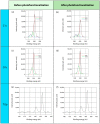Surface Activation of Titanium Dental Implants by Using UVC-LED Irradiation
- PMID: 33807532
- PMCID: PMC7961349
- DOI: 10.3390/ijms22052597
Surface Activation of Titanium Dental Implants by Using UVC-LED Irradiation
Abstract
Organic contaminants significantly limit the bioactivity of titanium implants, resulting in the degradation known as the ageing of titanium. To reactivate the surfaces, they can be photofunctionalized, i.e., irradiated with C-range ultraviolet (UVC) light. This descriptive in vitro study compares the effectiveness of novel light-emitting diode (LED) technology to remove contaminant hydrocarbons from three different commercially available titanium dental implants: THD, TiUnite, and SLA. The surface topography and morphology were characterized by scanning electron microscopy (SEM). The chemical compositions were analyzed by X-ray photoelectron spectroscopy (XPS), before and after the lighting treatment, by a pair of closely placed UVC (λ = 278 nm) and LED devices for 24 h. SEM analysis showed morphological differences at the macro- and micro-scopic level. XPS analysis showed a remarkable reduction in the carbon contents after the UVC treatment: from 25.6 to 19.5 C at. % (carbon atomic concentration) in the THD; from 30.2 to 20.2 C at. % in the TiUnite; from 26.1 to 19.2 C at. % in the SLA surface. Simultaneously, the concentration of oxygen and titanium increased. Therefore, LED-based UVC irradiation decontaminated titanium surfaces and improved the chemical features of them, regardless of the kind of surface.
Keywords: decontamination; dental implants; electron; hydrocarbons; microscopy; photoelectron spectroscopy; scanning; titanium; ultraviolet rays.
Conflict of interest statement
The authors declare no conflict of interest. The funders had no role in the design of the study; in the collection, analyses, or interpretation of data; in the writing of the manuscript, or in the decision to publish the results.
Figures




References
-
- Albrektsson T. Principles of Osseointegration. Mosby-Wolfe; London, UK: 1995.
MeSH terms
Substances
Grants and funding
LinkOut - more resources
Full Text Sources
Other Literature Sources

